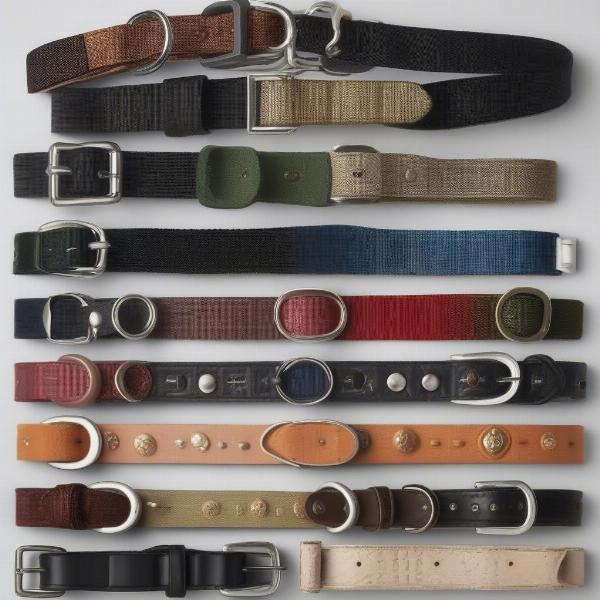A lock dog collar, also known as a locking collar or buckle collar, offers a secure fastening method for your dog’s collar, preventing accidental release. Choosing the right lock dog collar is crucial for your dog’s safety and comfort. This guide covers everything you need to know about lock dog collars, from different types and materials to choosing the right fit and ensuring proper use.
Types of Lock Dog Collars
There are several types of lock dog collars available, each offering a different level of security and functionality. Understanding the differences can help you make an informed decision.
-
Buckle Collars: These are the most traditional type, featuring a metal or plastic buckle similar to a belt. They offer a secure hold and are suitable for most dogs.
-
Martingale Collars with Locks: Martingale collars tighten slightly when a dog pulls, preventing them from slipping out. Adding a lock further enhances security, especially for dogs prone to escaping.
-
Quick-Release Collars with Locks: These collars offer the convenience of quick release but also feature a locking mechanism for added safety during walks or training.
-
GPS Tracker Collars with Locks: Some GPS tracker collars come with locking mechanisms to prevent the device from being removed. This is crucial for keeping track of your dog’s location.
Choosing the Right Material
The material of the lock dog collar also plays a vital role in comfort and durability.
-
Nylon: A popular choice due to its durability, affordability, and easy-to-clean nature.
-
Leather: A classic and stylish option, leather collars offer comfort and a sophisticated look, although they require more care.
-
Metal: Metal collars are incredibly strong and durable but can be heavy and uncomfortable for some dogs.
 Various Dog Collar Materials
Various Dog Collar Materials
Finding the Perfect Fit
A properly fitted collar is essential for your dog’s comfort and safety. Too tight, and it can restrict breathing; too loose, and your dog might slip out.
-
Measure Your Dog’s Neck: Use a flexible measuring tape to determine the circumference of your dog’s neck.
-
Add Extra Room: Add two fingers’ width to the measurement to ensure a comfortable fit.
-
Check Regularly: As your dog grows, re-check the fit and adjust as needed.
Using a Lock Dog Collar Safely
While lock dog collars offer added security, proper usage is crucial to avoid any potential hazards.
-
Supervise Your Dog: Always supervise your dog while wearing a lock collar, especially during playtime or training.
-
Avoid Leaving the Collar on Unattended: Remove the collar when your dog is crated or left alone to prevent entanglement.
-
Regular Inspection: Regularly check the collar for wear and tear, ensuring the lock is functioning correctly.
Why Choose a Lock Dog Collar?
dog walking bag A lock dog collar provides that extra layer of security, giving you peace of mind knowing your dog is less likely to escape, especially in exciting or stressful situations. This is particularly beneficial for dogs who are escape artists, easily startled, or in busy environments.
Conclusion
A lock dog collar offers a secure and reliable way to keep your dog safe. By understanding the different types, materials, and proper fitting techniques, you can choose the perfect lock dog collar for your furry friend, ensuring both their comfort and security. Remember to always supervise your dog while wearing a collar and perform regular checks for wear and tear.
FAQ
-
What is the difference between a lock dog collar and a regular collar? A lock dog collar has an added locking mechanism to prevent accidental release, providing extra security compared to a regular buckle collar.
-
Are lock dog collars suitable for all dogs? Yes, lock dog collars can be suitable for most dogs, but choosing the right type and fit is essential.
-
Can a lock dog collar be used for training? Yes, some lock dog collars, especially martingale collars with locks, can be useful training tools.
-
How do I clean a lock dog collar? Cleaning instructions vary depending on the material. Nylon collars can be washed with soap and water, while leather collars require specialized cleaning products.
-
What should I do if the lock on my dog’s collar breaks? Replace the collar immediately to ensure your dog’s safety.
-
Can I leave a lock dog collar on my dog all the time? It’s generally recommended to remove the collar when your dog is crated or unsupervised.
-
Where can I buy a lock dog collar? Lock dog collars are available at most pet stores and online retailers.
Expert Quote: “A properly fitted lock collar provides an important safety measure for dogs, particularly in busy or unfamiliar environments. Always prioritize your dog’s comfort and ensure regular checks for wear and tear.” – Dr. Emily Carter, Veterinary Behaviorist
Expert Quote: “For dogs prone to escaping, a lock dog collar provides that extra peace of mind. It’s a simple yet effective way to enhance their safety during walks and outings.” – John Davies, Certified Dog Trainer
ILM Dog is your trusted source for comprehensive information on dog care, breeds, and expert advice. We are dedicated to providing dog owners worldwide with the resources they need to nurture happy, healthy canine companions. From dog leash small to dog friendly walks, we cover all aspects of dog ownership. For expert guidance on dog breeds, health, training, nutrition, grooming, accessories, and more, explore our extensive library of articles and resources. Contact ILM Dog today for personalized support and expert advice: Email: [email protected], Phone: +44 20-3965-8624. Connect with us at ILM Dog.